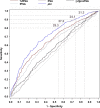Screening and Detection of Prostate Cancer-Review of Literature and Current Perspective
- PMID: 28546712
- PMCID: PMC5427029
- DOI: 10.1007/s13193-016-0584-3
Screening and Detection of Prostate Cancer-Review of Literature and Current Perspective
Abstract
Screening of prostatic cancer is a matter of debate among uro-oncologist. With many new screening modalities like prostatic health index (PHI), 4K testing the role of screening has increased as one is able to stratify patients with serum prostate specific antigen level in a grey zone of 4-10 ng/ml and normal digital rectal examination into various risk groups, thus avoiding unnecessary biopsy which was the pitfalls of routine screening practice. PHI is better at predicting malignancy while 4K is better at predicting high-grade disease. This in combination with multiparametric MRI especially with prostate imaging reporting and data system score has made screening less difficult and more meaningful for a practising uro-oncologist.
Keywords: Newer screening modalities; PIRADS; Prostate cancer; Screening.
Figures
Similar articles
-
Histology core-specific evaluation of the European Society of Urogenital Radiology (ESUR) standardised scoring system of multiparametric magnetic resonance imaging (mpMRI) of the prostate.BJU Int. 2013 Dec;112(8):1080-7. doi: 10.1111/bju.12259. Epub 2013 Aug 13. BJU Int. 2013. PMID: 23937255
-
mp-MRI Prostate Characterised PIRADS 3 Lesions are Associated with a Low Risk of Clinically Significant Prostate Cancer - A Retrospective Review of 92 Biopsied PIRADS 3 Lesions.Curr Urol. 2015 Jul;8(2):96-100. doi: 10.1159/000365697. Epub 2015 Jul 10. Curr Urol. 2015. PMID: 26889125 Free PMC article.
-
The eternal enigma in prostatic biopsy access route.Arch Ital Urol Androl. 2017 Oct 3;89(3):245-246. doi: 10.4081/aiua.2017.3.245. Arch Ital Urol Androl. 2017. PMID: 28969413
-
Multiparametric MRI in detection and staging of prostate cancer.Dan Med J. 2017 Feb;64(2):B5327. Dan Med J. 2017. PMID: 28157066 Review.
-
PSA Based Biomarkers, Imagistic Techniques and Combined Tests for a Better Diagnostic of Localized Prostate Cancer.Diagnostics (Basel). 2020 Oct 10;10(10):806. doi: 10.3390/diagnostics10100806. Diagnostics (Basel). 2020. PMID: 33050493 Free PMC article. Review.
Cited by
-
New Therapeutic Perspectives in Prostate Cancer: Patient-Derived Organoids and Patient-Derived Xenograft Models in Precision Medicine.Biomedicines. 2023 Oct 10;11(10):2743. doi: 10.3390/biomedicines11102743. Biomedicines. 2023. PMID: 37893116 Free PMC article. Review.
-
Biological Activity of Natural and Synthetic Peptides as Anticancer Agents.Int J Mol Sci. 2024 Jul 1;25(13):7264. doi: 10.3390/ijms25137264. Int J Mol Sci. 2024. PMID: 39000371 Free PMC article. Review.
-
The Impact of Metabolic Syndrome and Type 2 Diabetes Mellitus on Prostate Cancer.Front Cell Dev Biol. 2022 Mar 25;10:843458. doi: 10.3389/fcell.2022.843458. eCollection 2022. Front Cell Dev Biol. 2022. PMID: 35399507 Free PMC article. Review.
-
Magnetic resonance imaging-guided prostate biopsy-A review of literature.Asian J Urol. 2021 Jan;8(1):105-116. doi: 10.1016/j.ajur.2020.07.001. Epub 2020 Jul 28. Asian J Urol. 2021. PMID: 33569277 Free PMC article. Review.
-
Aptamer-Functionalized Natural Protein-Based Polymers as Innovative Biomaterials.Pharmaceutics. 2020 Nov 19;12(11):1115. doi: 10.3390/pharmaceutics12111115. Pharmaceutics. 2020. PMID: 33228250 Free PMC article. Review.
References
-
- Partin AW, Mangold LA, Lamm DM, Walsh PC, Epstein JI, Pearson JD (2001) Contemporary update of prostate cancer staging nomograms (Partin tables) for the new millennium. Urology 58(6):843–8. Available from: http://www.sciencedirect.com/science/article/pii/S0090429501014418 - PubMed
-
- Aslan G, Irer B, Cimen S, Goktay Y, Celebi I, Tuna B, et al. (2011) The performance of abnormal digital rectal examination for the detection of prostate cancer at stratified prostate specific antigen levels. Open J Urol 01(04):67–71. Scientific Research Publishing. Available from: http://www.scirp.org/journal/PaperInformation.aspx?PaperID=8221&#abstract
-
- Meeks JJ, Loeb S, Helfand BT, Kan D, Smith ND, Catalona WJ (2009) Characteristics of prostate cancers detected at prostate specific antigen levels less than 2.5 ng/ml. J Urol 181(6):2515–8; discussion 2518–9. Available from: http://www.sciencedirect.com/science/article/pii/S0022534709002729 - PMC - PubMed
-
- Catalona WJ, Smith DS, Ratliff TL, Dodds KM, Coplen DE, Yuan JJJ, et al. (1991) Measurement of prostate-specific antigen in serum as a screening test for prostate cancer N Engl J Med:1156–61. Available from: https://www.ncbi.nlm.nih.gov/pubmed/7506853 - PubMed
-
- Thompson IM, Pauler DK, Goodman PJ, Tangen CM, Lucia MS, Parnes HL, et al. (2004) Prevalence of prostate cancer among men with a prostate-specific antigen level < or =4.0 ng per milliliter. N Engl J Med 350(22):2239–46. Available from: http://www.ncbi.nlm.nih.gov/pubmed/15163773 - PubMed
Publication types
LinkOut - more resources
Full Text Sources
Other Literature Sources

